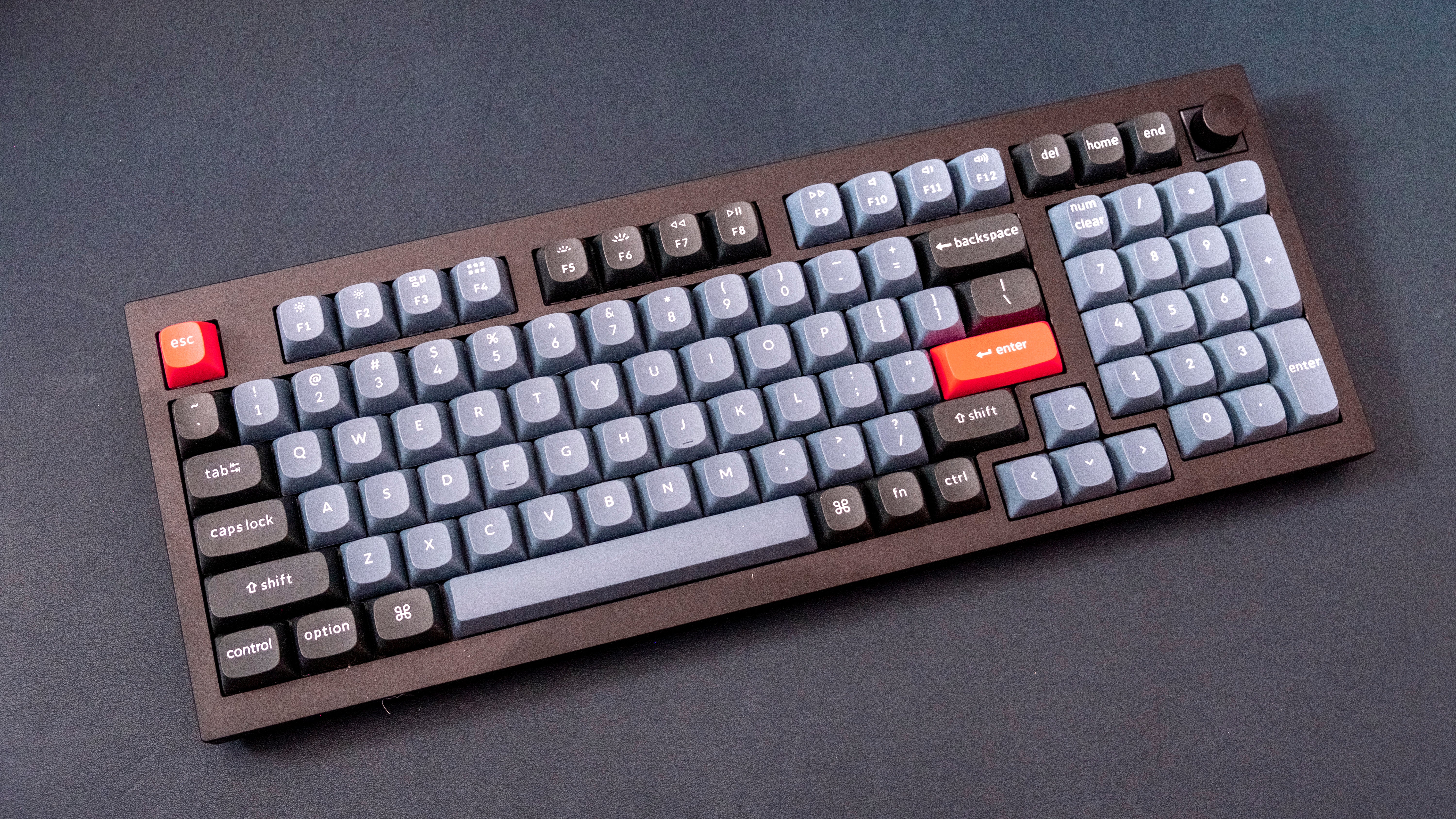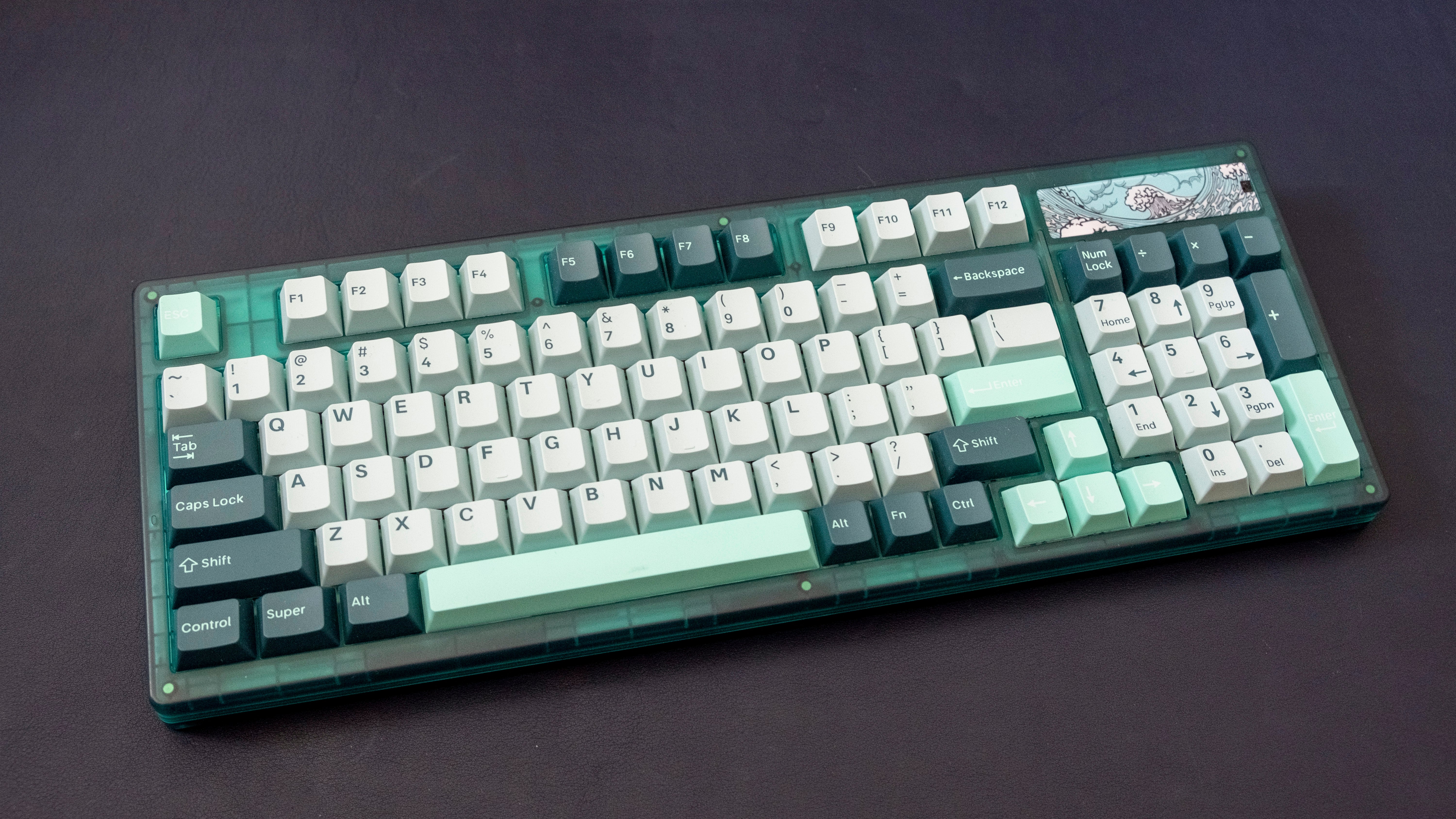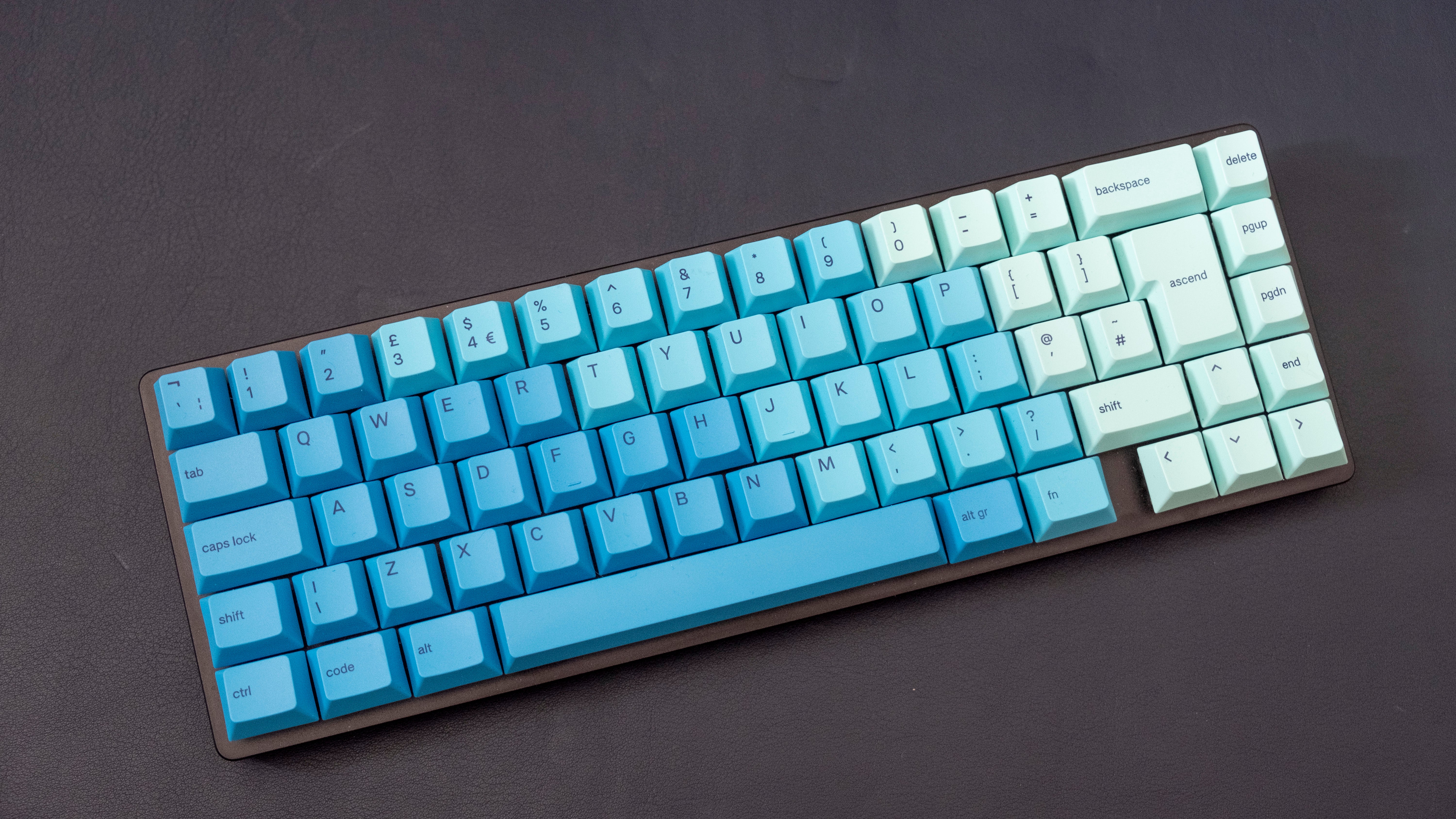It feels like there’s something of a mechanical keyboard renaissance recently, with boutique brands producing some stunning keyboards with unique designs and advanced features for surprisingly little money. I’ve selected five of the best that have passed over my desk in the first half of the year, from ultra-premium numbers to more affordable options, so take a look - even if you’re not a mechanical keyboard fan, you might find something that sparks something here.
The five best mechanical keyboards I’ve tested this year:
1. Lofree 1% Dual Mode Mechanical Keyboard
The Lofree 1% is a keyboard looks like a giant ice cube - what more do you want?! Almost everything here is at least partially transparent, from the keycaps and the switches to the chassis, while other components like the PCB are coloured white or silver to add to the gleaming effect. Combined with strong white backlighting behind each key, and you get a keyboard that looks like no other on the market. The only disappointment? The USB-C cable is a standard black affair, so I’d recommend picking up an aftermarket cable if you’re going to use it wired. As a keyboard, the 1% is also pleasant to use. The soft linear Kailh Jellyfish switches and slightly rounded keycaps make it a good choice for gaming, while the 65 percent layout (including arrow keys and navigation keys on the right side) means that it works nicely for writing and editing text as well. A function key, improbably placed in the upper right corner, allows access to everything that lacks a physical key - like F1 through F12, Home and End, Printscreen and so on - as well as backlighting controls. A switch on the bottom of the keyboard allows it to switch between Mac and Windows layouts, as well as between Bluetooth and wired modes. The 1% is the most expensive keyboard on this list at $219, but you do get something that’s quite out of the ordinary - and practical as well. It’s available from the Lofree site, as well as resellers such as Mechkeys.com and TheWorkAlley.co.uk.
2. Keychron Q5 QMK Custom Mechanical Keyboard
The Keychon Q5 is the latest keyboard to pass over my desk, and when I first plunked it down my monitors rocked - this thing is heavy at 2.3kg or 5 pounds; you could probably use it as an improvised bludgeon in case of a zombie apocalypse. The mass of the Q5 is down to its full aluminium chassis, steel plate and two layers of gaskets, sound-dampening foam and thick PBT keycaps. You can feel that weight when you’re typing on it too, with the Q5 producing a pleasantly weighty tone with every key press, and of course there’s no sign of flexion either. The Q5 is available in quite a few configurations, something that maker Keychron have made their signature. There are three basic types - fully assembled, barebones ANSI (US) and barebones ISO (EU) - each of which can come with a volume knob in the upper right corner or an extra key - plus three colour variations and three switch choices. My sample is Fully Assembled Knob (not sure how they guessed my high school nickname), Carbon Black - B with Gateron G Pro Brown switches, and costs $195 - while even the barebones no knob (heh) kits cost $165, so you may as well take your choice of switches and keycaps. Thankfully, both Mac and Windows keycaps are provided in the box, and you can flip a switch on the back to change the bindings to use the keyboard with either OS without needing to reconfigure anything. Beyond the slightly odd (and high for Keychron!) pricing, there’s little to complain about with the Q5. Yes, it’s certainly not a good size or weight to be toted onto a train or into a café, but it feels good to use, looks great and key bindings and lighting can be programmed via an app or via QMK/VIA firmware updates. And if you need a keyboard to reënact that scene from Wanted, this is the one I’d choose.
3. Yunzii Keynovo IF98 Hot-Swappable Gasket Mounted Mechanical Keyboard
The Keynovo, or to use its full name, the Yunzii Keynovo IF98 Hot-Swappable Gasket Mounted Mechanical Keyboard, is perhaps the keyboard that is closest to an actual work of art - mostly because it has a beautiful Great-Wave-off-Kanagawa-esque badge in the upper right corner. Interestingly, beneath this badge are sockets for four more switches - so if art’s not your bag, then you can instead opt for a keyboard with 98 keys instead of 94. The rest of the keyboard is incredible too, with a semi-transparent plastic teal chassis, an aquamarine nameplate on the bottom and a gold inscription stating ‘one click to infinity’. The keycaps are made from high-quality doubleshot PBT, and come in three complementary green-ish colours. I was thoroughly impressed with the thought that’s gone into the design here, and if green doesn’t float your boat, there are black and white colourways with a similar level of artistic excellence. It’s all very well and good to make an attractive keyboard, but the Keynovo would also impress even if you used it blindfolded. The high-end keycaps, sound-absorbing silicone padding and Gateron gasket-mounted switches provide incredibly smooth action and a pleasant dull ’thock’ as you type, while the compact 96 percent layout makes a lot of sense for anyone that uses a numpad but would prefer a smaller keyboard - even if the relocation of Delete and PrtScr to a function layer can be tough to adjust to. Thankfully, you can program the keyboard with the included software, and the four included extra keys make up for any omissions in the default 94-key layout. Similarly, the keyboard’s switches are hotswappable and support both common MX-style switch types (3-pin and 5-pin), so you can always use your own switches if you prefer. Given the outstanding design, build quality and features, the Keynovo is surprisingly affordable - it’s currently $129 at the Yunzii site after a $20 discount including free worldwide shipping. When you consider that standard full-size keyboards from the likes of Razer and Corsair are the same price or higher, it’s kind of incredible how much better the Keynovo looks and feels.
4. Glorious GMMK 2 Modular Mechanical Keyboard
The Glorious GMMK 2 is the most straightforward and easy-to-recommend keyboard on this list. It’s available in compact (65 percent) and full-size (96 percent) form factors, you can put in whatever switches, keycaps and cables you want, and you can get it pre-assembled ($120/£110) or as a barebones kit ($80). You can even program the keyboard, either in the intuitive Glorious Core app, or do more complicated things via the more widely used QMK firmware. It’s a low profile keyboard, with the keycaps sitting above an aluminium frame, and it feels weighty and well-assembled with no sign of deck flex. There are some nice touches here - like foam to dampen unpleasant pinging sounds common in some keyboards and some extra RGB lighting in a strip on the left and right sides - but mostly this is just a straightforward, comfy keyboard that will change drastically based on the keycaps and switches you choose. Glorious sent me a selection of switches, keycaps and cables, and I ended up with some pleasant teal and blue keycaps, a curly pink two-part cable and with soft, linear Kailh Box Red switches that work well for typing and gaming. The finished article tends to attract attention from house guests (I assume everyone takes keyboard questions when their significant other is having a party?) and it’s so pleasant and unannoying to use that it’s remained on my desk far longer than is strictly necessary for a review - always a good sign that I’m getting on well for a keyboard. The other keyboards on this list are fairly specialised and I wouldn’t recommend them to absolutely everyone - especially given some come at a pretty steep price - but the GMMK 2 makes for an awesome introduction to mechanical keyboards at a very fair price.
5. Razer Huntsman Mini Analog
The Razer Huntsman Mini Analog looks dead-basic compared to the previous keyboards - but the interesting stuff is inside. Each switch is trigged by an optical sensor, which knows not just that a key has been pressed down, but exactly how far it’s been pressed down. That lets you do some rather neat stuff - like using WASD as a joystick or assigning different actions to different stages of a keypress, like switching to a grenade with the start of your press and then throwing it when you bottom out the key. The possibilities are exciting, but it does take a period of sitting down and really wrapping your head around things before it starts to become useful. My favourite factoid is that you can use these keys to walk faster than the default walking speed in CS:GO, without making the footsteps of the default running pace. This is kind of game-breaking, letting you scarper away silently faster than you should, and I’m expecting to see these sorts of keyboards used by pro players any day now. If you’re interested in experimenting but don’t want to be lumbered with a one-trick-pony, the Huntsman Mini Analog is also just a nice keyboard to use. The 60 percent layout works well for gaming (less well for writing, as there’s no arrow keys), there’s an aluminium frame for rigidity, and the PBT keycaps feel better than the ABS ones you’ll see on most Razer keebs. You even get the secondary functions of each key printed on the side of the keycap, so you don’t have to study the manual to work out how to press something like PrtScr or Page Down. The low weight ensures it’s worth tossing in a bag to use instead of your laptop’s crummy built-in keyboard, and the detachable cable and onboard memory make it a good shout for LAN parties too. The standard Huntsman Mini does tend to cost about half the price (~£55/$100), but if you can get a good deal on the (~£110/$150) Analog I’d go for it every time.
Wrapping up
I hope you found this look at the world of mechanical keyboards in 2022 interesting - it feels like we’re really seeing a big evolution in designs, with custom keycap sets, gasketed sockets and fancy, hotswappable switches becoming almost table stakes from boutique vendors - stuff that you would pay through the nose for just a few years back. There’s been a massive expansion in the layouts available too, with some really innovative styles that pack in nearly as many keys as full-size boards but exist within a much smaller footprint. And while these designs represent some of the upper-end options, getting a dead-basic mechanical keyboard is cheaper than ever before - I even tested a £23 model a couple years back. It’s an awesome time to get into the hobby, so I hope you’ll join me! If you have any questions, do let me know, I could talk about this stuff for hours - which, from the length of this article, you could probably tell! You can also take a look at my picks for the best mechanical keyboards, which include more mainstream brands if you’re into that kind of thing.




